When choosing baby formula for infants with allergies, it can be difficult to know where to start. Specific formulas contain ingredients that can trigger allergic reactions in babies, so choosing the right formula that meets your baby’s nutritional needs is essential.
This blog post will delve into the common allergies associated with baby formulas, including cow’s milk protein allergy, soy allergy, and lactose intolerance, and the symptoms to watch out for.
The article also recommends safe and allergy-friendly baby formula brands and ingredients to avoid. Finally, the post discusses how to mix baby formula safely to ensure your baby gets the necessary nutrients and stays healthy. With these tips and guidelines, parents can choose the right formula for their child’s unique needs and ensure their well-being.
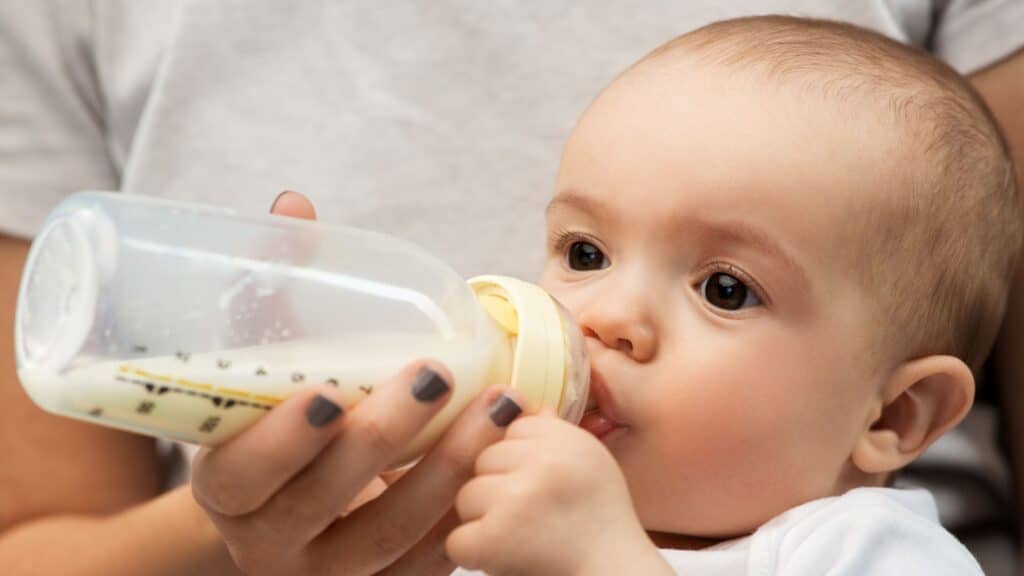
Understanding Baby Formula Allergies
As a parent, it is essential to be aware of potential allergies your baby may have to specific formulas, whether they are breastfed or formula-fed babies. The most common allergy types associated with baby formula include cow’s milk protein allergy, soy allergy, and lactose intolerance. By understanding these allergies and their symptoms, you can ensure your baby receives proper nutrition and care.
Cow’s Milk Protein Allergy (CMPA)
Cow’s milk protein allergy is one of the infants’ most common food allergies, affecting approximately 2-3% of babies. It occurs when the immune system mistakenly identifies cow milk proteins as harmful and reacts against them.
Symptoms of CMPA can vary from mild to severe and may include:
- Skin reactions such as eczema, hives, or rashes
- Gastrointestinal symptoms like vomiting, diarrhea, or abdominal pain
- Respiratory symptoms such as wheezing or coughing
- Colic or excessive fussiness
If you suspect your baby is experiencing a cow’s milk protein allergy, it’s crucial to consult with a pediatrician. They may suggest transitioning to a hypoallergenic formula or extensively hydrolyzed formula as alternatives. In some cases, if store-bought options are not suitable, a pediatrician may guide you on safely preparing homemade baby formula, ensuring it meets your baby’s nutritional needs.
Soy Allergy
Soy allergy is another common food allergy in infants, affecting approximately 0.4% of babies. It occurs when the immune system reacts to proteins found in soy products, including soy-based infant formulas.
Symptoms of a soy allergy can be similar to those of CMPA and may include:
- Skin reactions such as redness, itching, or swelling
- Gastrointestinal symptoms like vomiting or diarrhea
- Respiratory symptoms such as difficulty breathing or wheezing
- Anaphylaxis is a severe and potentially life-threatening allergic reaction
If you suspect your baby has a soy allergy, consult your pediatrician, who may recommend a different type of hypoallergenic formulas.
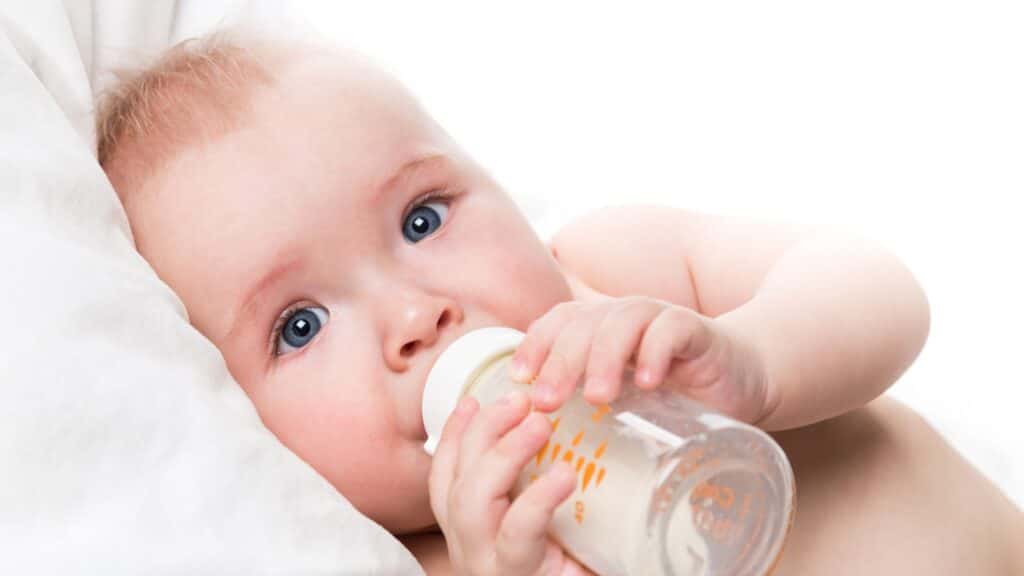
Lactose Intolerance
Lactose intolerance is not an allergy but a digestive issue where the body cannot properly break down lactose, a sugar in milk and milk products. It is relatively uncommon in infants, but it may still occur.
Symptoms of lactose intolerance in babies may include:
- Excessive gas
- Diarrhea
- Abdominal pain or bloating
- Irritability or fussiness
If you suspect your baby has lactose intolerance, consult your pediatrician, who may recommend a lactose-free or reduced-lactose formula.
When To Consult a Pediatrician
Should your baby display any symptoms of formula allergy or intolerance, consulting a pediatrician is crucial. They possess the expertise to evaluate your baby’s symptoms, render a diagnosis, and suggest an appropriate formula or treatment plan, which may include breast milk, store-bought formulas, or even homemade baby formula if deemed safe.
Being well-informed about typical baby formula allergies and their symptoms aids in recognizing potential issues and promptly seeking professional guidance. Adhere to the American Academy of Pediatrics’ recommendations and always consult your pediatrician if you have concerns regarding your baby’s health. They will direct you in providing the best possible care for your child.

Identifying Safe and Allergy-Friendly Baby Formula Brands
Choosing the right baby formula for infants with allergies or sensitivities can be daunting, as different babies may have varying reactions to specific ingredients. Whether your baby needs to avoid cow’s milk formula, soy formula, or milk protein, there are various options available to cater to their needs.
Here are some of the best baby formula brands for infants with allergies:
Nutramigen with Enflora LGG (Mead Johnson)
Nutramigen, a hypoallergenic formula by Mead Johnson, is crafted specifically for infants with cow’s milk protein allergies. This formula features extensively hydrolyzed casein, meaning the milk proteins have been broken down into smaller, more digestible particles.
In addition to catering to cow’s milk protein intolerance, Nutramigen also contains probiotics that help foster a healthy gut microbiome in your baby.
Alimentum (Similac)
Alimentum is another hypoallergenic formula designed for infants with cow’s milk protein allergy or lactose intolerance. It features extensively hydrolyzed casein and is lactose-free, making it suitable for infants’ sensitivities to milk proteins and lactose.
EleCare (Abbott)
EleCare is an amino acid-based formula suitable for infants with severe food allergies, including cow’s milk protein and soy allergies. It is also suitable for infants with multiple food protein intolerances and gastrointestinal disorders. This hypoallergenic formula is free of milk proteins, soy proteins, and lactose.
Neocate (Nutricia)
Neocate is another amino acid-based formula for infants with severe food allergies, multiple food protein intolerances, and gastrointestinal disorders. It is free of milk proteins, soy proteins, and lactose, making it suitable for infants with various sensitivities.
Ingredients to Avoid:
For infants with allergies or sensitivities, it’s essential to avoid certain ingredients in baby formulas, such as:
- Whey protein and casein are the primary proteins found in cow’s milk and can trigger allergic reactions in babies with cow’s milk protein allergy.
- Soy protein: In soy-based formulas, soy protein can cause allergic reactions in infants with soy allergies.
- Lactose: This sugar in milk can cause digestive issues in infants with lactose intolerance.
As you navigate the world of baby formulas – from cow’s milk formula to soy formula, partially hydrolyzed formulas to hypoallergenic ones – it’s vital to remember that every baby’s needs are unique.
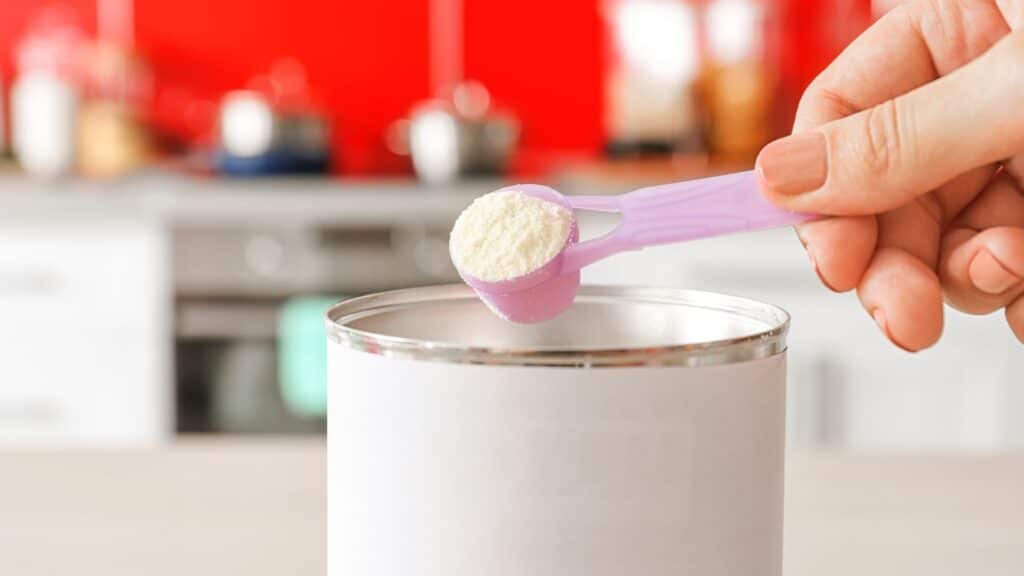
Is Homemade Baby Formula Safe?
When it comes to feeding your little one, ensuring their safety and proper nutrition is a top priority. Many parents may consider homemade baby formula, but is it really safe? In this article, we’ll discuss the safety of homemade baby formula and provide a step-by-step guide to mixing baby formula safely, including sterilizing bottles and preparing the formula in advance.
While homemade baby formula may sound appealing for its potential cost savings and natural ingredients, it’s important to understand the risks involved. According to the American Academy of Pediatrics (AAP) and the World Health Organization (WHO), homemade baby formulas can pose serious health risks to infants.
These risks include potential contamination, nutritional imbalances, and inadequate nutrient content. It is recommended to use commercially prepared infant formula, which is carefully formulated to meet the specific nutritional needs of babies.
How to Mix Baby Formula Safely
Properly mixing baby formula ensures your child gets nutrients and maintains health.
Here is the process of mixing baby formula safely, focusing on sterilizing bottles and preparing the formula in advance.
Gather necessary supplies:
- Powdered infant formula
- Clean, sterilized baby bottles, nipples, and caps
- A measuring scoop (usually provided with the formula)
- Fresh, safe water (tap or bottled, as recommended by your pediatrician)
Sterilize the bottles:
- Before using bottles for the first time or after each use, sterilize them by washing them in hot, soapy water and rinsing thoroughly or by using a dishwasher with a sanitized setting.
- For extra sterilization, boil the bottles, nipples, and caps in a large pot of water for 5 minutes and allow them to air-dry on a clean rack or towel.
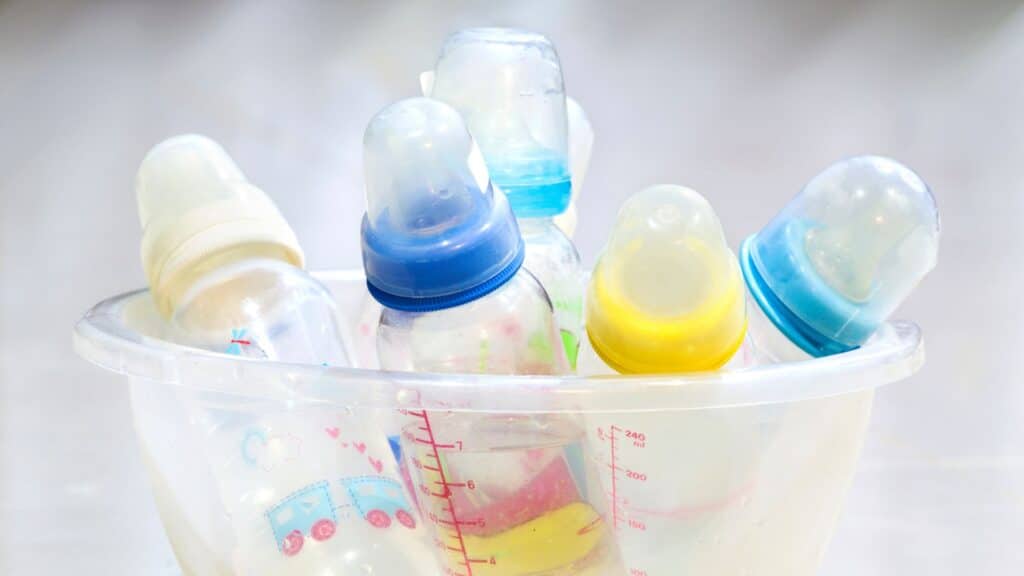
Boil the water:
- Boil fresh water for one minute to ensure it’s safe and impurities-free. Allow the water to cool to room temperature before mixing it with the formula powder.
Measure the water and formula:
- Check the formula packaging for the recommended water-to-powder ratio.
- Pour the required amount of cooled, boiled water into the sterilized bottle using a sterilized measuring cup.
- Carefully scoop the recommended formula powder into the bottle, leveling off each scoop to ensure accurate measurements.
Mix the formula:
- Secure the nipple and cap onto the bottle, ensuring they’re tightly fastened.
- Gently shake the bottle until the formula powder is completely dissolved and well mixed. Avoid creating many bubbles, as this can cause gas in your baby’s stomach.
Check the temperature:
- Before feeding your baby, test the formula’s temperature by placing a few drops on your wrist. It should feel slightly warm but not hot.
Storing prepared formula:
- If you need to store prepared formula, refrigerate it immediately in a sealed, sterilized container and use it within 24 hours.
- Never store mixed formula at room temperature, which can lead to bacterial growth.
Warming refrigerated formula:
- Warm the refrigerated formula by placing the bottle in a container of warm water for a few minutes. Do not use a microwave, which can create hot spots in the formula.
It’s important to remember that every baby’s needs are unique, and their nutritional requirements may change as they grow. Whether you choose breast milk, store-bought formulas like partially hydrolyzed formulas or extensively hydrolyzed formulas, or even homemade baby formula (if deemed safe by a pediatrician), always consult with a healthcare professional to ensure you’re meeting your baby’s specific needs.
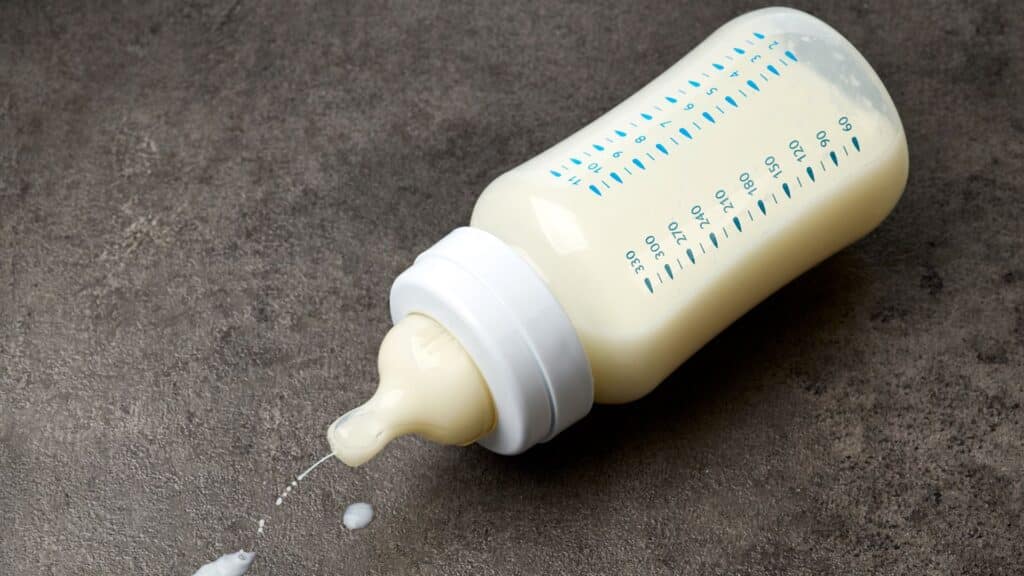
Tips for Transitioning to Allergy-Friendly Baby Formula
Transitioning to a new baby formula can be challenging, especially if your baby is used to a particular taste or texture.
Here are some tips for making the transition to allergy-friendly baby formula as smooth as possible, including gradually introducing the new formula and monitoring your baby’s reaction.
Consult a pediatrician: Before making any changes to your baby’s formula, it’s essential to consult a pediatrician or a registered dietitian to ensure the new formula is safe and suitable for your baby’s needs.
Gradual introduction: Instead of switching to the new formula, gradually mix the allergy-friendly baby formula with the current one. Start with a small amount of the new formula and progressively increase the ratio over a week or two. This will help your baby adjust to the taste and texture, making it easier for them to accept the change.
Follow the mixing instructions: When mixing formulas, follow the manufacturer’s instructions carefully for the proper ratio. This ensures that your baby is getting the correct nutrients and consistency.
Monitor your baby’s reaction: As you introduce the new formula, watch your baby’s reaction closely. Look out for any signs of discomfort, gas, or changes in bowel movements. Stop the introduction and consult your pediatrician immediately if you notice any adverse reactions.
Maintain a feeding routine: Keeping a consistent feeding routine can be helpful during this transition. Stick to the same feeding times and locations to provide a sense of familiarity for your baby.
Be patient: It may take some time for your baby to adjust to the new formula, so be encouraged if they initially resist the change. Remember to be patient and persistent, as it may take several tries before your baby fully accepts the new formula.
Offer comfort and reassurance: During this transition, providing comfort and reassurance to your baby is essential. Hold them close, sing, or talk to them while feeding them to create a soothing environment.
Evaluate progress: After a few weeks of the transition, evaluate your baby’s progress. If they have adjusted well to the new formula without any adverse reactions, you can continue using the allergy-friendly formula exclusively.
Keep track of allergens: If your baby has a known allergy, keeping track of the allergens in their diet is essential. This can help to prevent accidental exposure and aid in managing their allergy more effectively.
Stay informed: Stay informed about the latest developments in allergy-friendly baby formula and research. This can help you make better decisions for your baby’s nutritional needs and ensure they receive the best care.
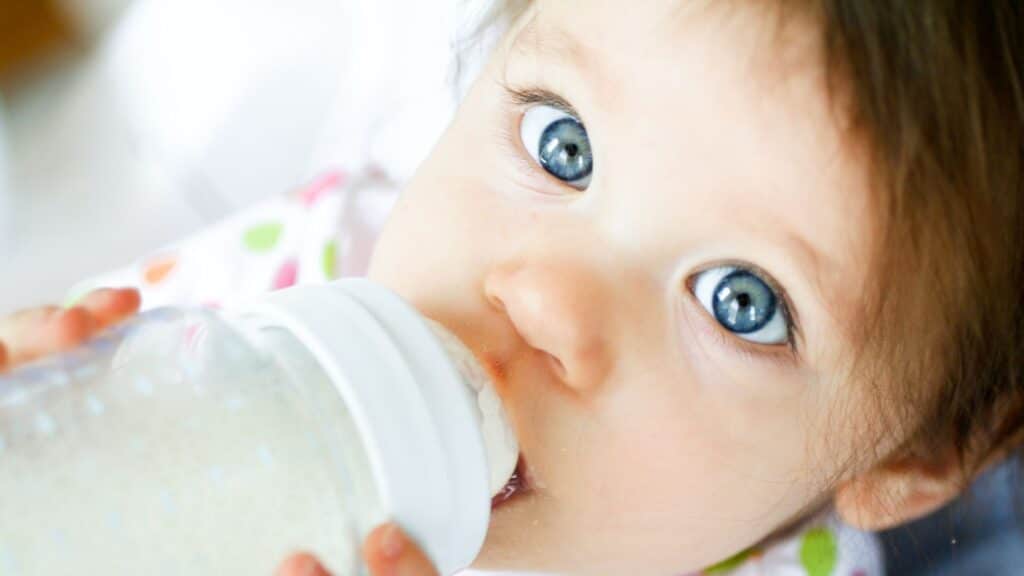
Conclusion
Selecting an appropriate baby formula for your little one can be daunting, particularly when faced with allergies. Various allergies can be linked to baby formulas, such as cow’s milk protein allergy, soy allergy, and lactose intolerance. Recognizing these allergies and their symptoms is crucial to guarantee your baby’s proper nourishment and care.
Parents should seek advice from a pediatrician if they observe any signs of allergy or intolerance. Numerous safe and allergy-friendly baby formula brands, including Nutramigen,
Alimentum, EleCare, and Neocate, cater to infants with varying sensitivities. Additionally, parents must steer clear of specific ingredients in baby formulas, such as whey protein, casein, and soy protein.
By adhering to these suggestions and guidelines, parents can make an informed choice regarding the ideal formula for their child’s distinct requirements, promoting their overall well-being.
Did this article help you? We’d love to hear from you! Please leave a comment below or send us an email.



